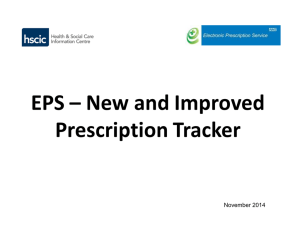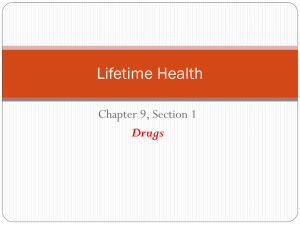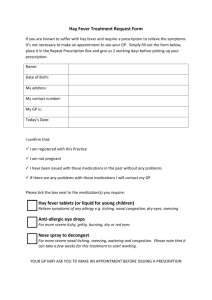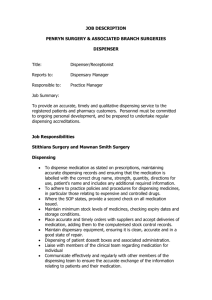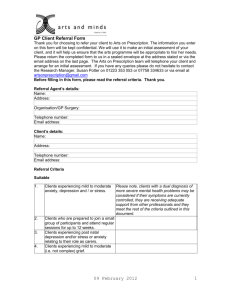P1. Ordering, Receipt and Storage of CDs
advertisement
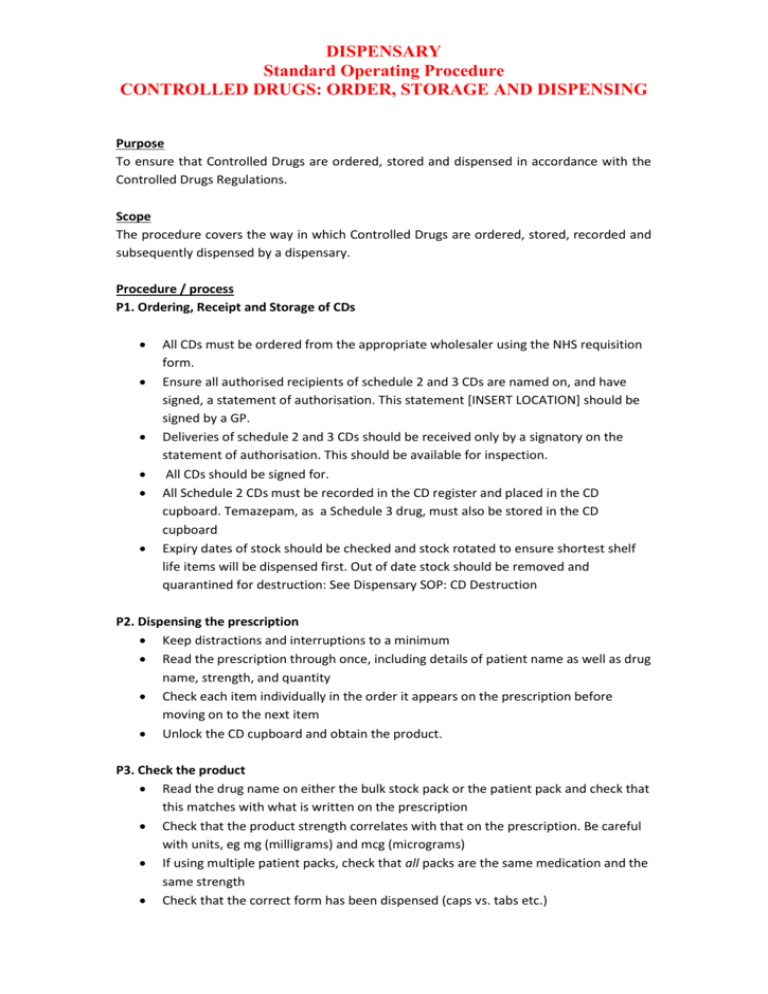
DISPENSARY Standard Operating Procedure CONTROLLED DRUGS: ORDER, STORAGE AND DISPENSING Purpose To ensure that Controlled Drugs are ordered, stored and dispensed in accordance with the Controlled Drugs Regulations. Scope The procedure covers the way in which Controlled Drugs are ordered, stored, recorded and subsequently dispensed by a dispensary. Procedure / process P1. Ordering, Receipt and Storage of CDs All CDs must be ordered from the appropriate wholesaler using the NHS requisition form. Ensure all authorised recipients of schedule 2 and 3 CDs are named on, and have signed, a statement of authorisation. This statement [INSERT LOCATION] should be signed by a GP. Deliveries of schedule 2 and 3 CDs should be received only by a signatory on the statement of authorisation. This should be available for inspection. All CDs should be signed for. All Schedule 2 CDs must be recorded in the CD register and placed in the CD cupboard. Temazepam, as a Schedule 3 drug, must also be stored in the CD cupboard Expiry dates of stock should be checked and stock rotated to ensure shortest shelf life items will be dispensed first. Out of date stock should be removed and quarantined for destruction: See Dispensary SOP: CD Destruction P2. Dispensing the prescription Keep distractions and interruptions to a minimum Read the prescription through once, including details of patient name as well as drug name, strength, and quantity Check each item individually in the order it appears on the prescription before moving on to the next item Unlock the CD cupboard and obtain the product. P3. Check the product Read the drug name on either the bulk stock pack or the patient pack and check that this matches with what is written on the prescription Check that the product strength correlates with that on the prescription. Be careful with units, eg mg (milligrams) and mcg (micrograms) If using multiple patient packs, check that all packs are the same medication and the same strength Check that the correct form has been dispensed (caps vs. tabs etc.) DISPENSARY Standard Operating Procedure CONTROLLED DRUGS: ORDER, STORAGE AND DISPENSING If using patient/calendar packs, open all unsealed packs checking that the contents are correct, the number of strips present in each pack is correct, and that there are no loose blisters or tablets Check that the pack contains the relevant PIL, or that a leaflet is supplied; these can be downloaded from the internet Check that the correct quantity has been given (the correct number of patient packs or a visual check of the container) Double-check and count the number of dosage units dispensed Check the expiry date on each patient pack Record the Batch Number/s of each pack on the Prescription P4. Check the label 1. Check the label against the prescription (not against what has been dispensed) to ensure that it contains the correct patient name, correct medication name, correct strength, quantity, and dosage form 2. Check that the dose and usage instructions on the label correspond with the prescription 3. Check that the batch number of the pack matches the batch number on the prescription. P5. Complete the checks When the accuracy check is complete, initial the dispensing label If any of the above steps reveals that an error has been made, this must be brought to the attention of the dispenser concerned. Errors should be recorded, and any trends should be brought to the attention of the doctor in charge. Count the number of items on the prescription and then count the corresponding number of dispensed items (not packs) into an appropriately sized bag Check that you have not included any stock containers in the bag Hand the dispensed items to the patient in accordance with the dispensary SOP: Transferring dispensed items to patients Ensure the patient signs the prescription in the “purple box” on the back of the script. If a representative of the patient is collecting the prescription, ensure they sign the “purple box” and complete their details on the back of the prescription If the patient is collecting the prescription at a later time, store the dispensed items in the Controlled Drugs cupboard. P6. Record keeping The collection of Schedule 2 CDs should be recorded in the CD Register as soon as the CD is collected. If necessary ask another dispenser to take over so this task can be completed The following information should be recorded: DISPENSARY Standard Operating Procedure CONTROLLED DRUGS: ORDER, STORAGE AND DISPENSING Whether it was the patient, their representative or a health care professional who collected the prescription Whether the identity of the person collecting was requested If a health care professional collects the CD, the name and address of the health care professional MUST be entered into the CD register Responsibility for Controlled Drugs All dispensers are responsible for the CD register, but the GP, as the Responsible Person, has overall responsibility for ensuring that the Register is correct and kept up to date. Doctors who access the Controlled Drug Cupboard MUST ensure that the Register is completed by the dispensers. Access to Controlled Drugs Only dispensers and doctors can have access to the Controlled Drugs Cupboard. The key must be kept in a [insert secure location]. If at all possible, the CD Cupboard should be accessed on every occasion by at least two persons. If the CD Cupboard has been accessed by only one person, this should be recorded at the next available opportunity. Reporting of adverse events All adverse events regarding CDs must be reported to the responsible person and an adverse event form completed. This will be discussed at the next available clinical governance meeting. If appropriate, serious adverse events will be reported in an anonymised format to the local contracting organisation. Review procedure This procedure will be reviewed following: Changes in the law affecting dispensing and Controlled Drugs Changes in DDA or other guidelines affecting the dispensing process Change of staff Any adverse dispensing incident In the absence of any of the above, on or before the date shown below. Known risks Only one person accessing the CD cupboard Failure to record in the CD Register at the time of delivery and of dispensing Distractions or interruptions Working long hours without a break Quieter periods (research shows that fewer errors occur when the dispensary is busy) Illness/lack of focus/personal problems Over-reliance on accuracy of person who dispensed the medication Self-checking DISPENSARY Standard Operating Procedure CONTROLLED DRUGS: ORDER, STORAGE AND DISPENSING New staff, locums, etc. I have read and understood this standard operating procedure Name Prepared by: Effective from: Version no.: Date of preparation: Position held Signature Date DISPENSARY Standard Operating Procedure CONTROLLED DRUGS: ORDER, STORAGE AND DISPENSING Date of review: Signature:
